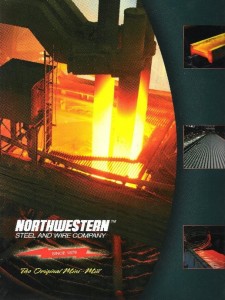Welcome to the unofficial website for Northwestern Steel & Wire Company. My name is Dana Fellows and I worked at Northwestern Steel & Wire for about 15 years until it closed down in 2001. This site is my attempt to keep a little bit of life into the company I worked for. If you have pictures or stories that you would like to share, email me at danafellows@gmail.com.
See more about Northwestern Steel & Wire Company on our Facebook Page
The following was ‘borrowed’ from Wikipedia.
The beginning of Northwestern Steel and Wire Co. (NWSW) can be traced back to W.M. Dillon’s move to Rock Falls, Illinois from Ohio. He founded Northwestern Barbed Wire Co. upon his arrival in 1879. In 1892 Dillon partnered with J.W. Griswold to form Dillon-Griswold Company. Dillon-Griswold produced barbed wire, bale ties, drawn wire, and nails. Dillon left the company in 1902 to devote himself fully to his own Rock Falls operation. By 1912 the Griswold Company had landed itself in receivership and its assets were liquidated to the Lawrence Brothers of Sterling, Illinois. Within the next week Dillon had purchased the Griswold Co. from the Lawrence Brothers and moved Northwestern Barbed Wire to Sterling.
In 1936 Washington Dillon’s son, P.W. Dillon, installed two electric furnaces and rolling machines in the barbed wire factory in order to make low carbon steel. Two years later the company became known as Northwestern Steel and Wire. The systems and furnaces were successively upgraded in the ensuing years. During WWII, to keep up with escalating demand, two 50 ton electric furnaces were installed. By 1950 150 ton furnaces were in use. Throughout the years, as production increased, larger furnaces became the norm.
In the years following the end of WWII, Northwestern Steel and Wire attracted workers from several states away, especially from the Southern states such as Texas and Oklahoma that were in the midst of a post-war recession. These workers were housed in 100 railroad box cars converted to homes and arranged in 4 rows of 25 each along the Rock River. The cars were all painted silver with paint left over from the war and the residents referred to the place as “Silver City”. The rental charges were taken out of the employee’s pay and there was a “Company Store” adjacent that could be used to buy groceries with company credit.
By 1968 NWSW installed a massive 250 ton furnace but it was during the 1970s that the scale of the furnaces at the Sterling plant became truly enormous. In 1971 and 1976 two 400 ton Electro-Melt furnaces were put in place, by George F Reitzel Electric. Those were the largest furnaces in the world at the time. A third furnace was converted to 400 ton capacity in 1979. In the same year NWSW employed 4,678 people, the highest number it ever employed as Whiteside County’s largest industry.
The 1980s started with a worldwide steel depression. That, coupled with stiffer competition, resulted in a significant downturn for the company. For example, during the fourth quarter of 1984 NWSW lost $15.8 million. During the same period a year later they lost $10.4 million.
Northwestern Steel used steam locomotives to move scrap metal to the furnaces and to transfer hot ingots to the rolling machines, long after the era of steam engines was bygone in the broader culture. The company usually bought second hand “switchers” from railroads such as the Illinois Central. The engines used in the mill weren’t graceful or agile, like many of those that once pulled passenger trains. They were unseemly and barely capable of moving 40 mph.
In 1960 15 steam locomotives came in from the Grand Trunk Western Railroad. NWSW, seeing that a few were in good shape, decided not to scrap them all but rather use them in the scrap yard. Estimates stated that the engines would go through one ton of coal for each hour in the day and use up 48,000 gallons of water during the same time period.
Northwestern Steel’s steam engines were among the last to operate in the United States. Old No. 73, as it was known, (a 1929 Baldwin locomotive) was the final steam engine to be used in America. NWSW last used the locomotive on Dec. 3, 1980 at 10 a.m. Its final “run” occurred hitched onto the technology that replaced it, a diesel engine. On Jan. 19, 1981, No. 73 was moved to the south lawn of the Paul W. Dillon Home. From tracks inside the steel mill complex, the locomotive was taken east along the Geneva Subdivision main line of the Chicago & North Western Railroad a mile and a half to a location which passes just behind the Dillon home. 73 was then lifted via four cranes and moved the last 75 yards to its final resting place as a memorial to Dillon, the man who kept the idea of steam engines alive for more than twenty years.
On Oct. 7, 1998 NWSW announced its intention to cease production of most of its wire products. At the time its work force hovered around 2,000. With the company’s announcement, over 400 people were laid off, bringing the total employed to 1,503. Dec. 19, 2000 the company filed a voluntary petition for reorganization under Chapter 11 of the United States Bankruptcy Code; the company lost more than $83 million that year. On May 18, 2001 Northwestern Steel and Wire, a staple of Sterling for over 100 years shut its doors forever.
Leggett and Platt, a Fortune 500 company, later reopened a portion of the old mill with a new name, Sterling Steel Company LLC (SSC).

